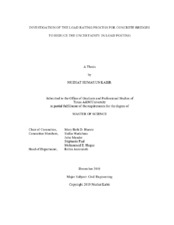| dc.contributor.advisor | Hueste, Mary Beth D | |
| dc.creator | Kabir, Nuzhat Humayun | |
| dc.date.accessioned | 2020-09-10T16:00:37Z | |
| dc.date.available | 2021-12-01T08:43:03Z | |
| dc.date.created | 2019-12 | |
| dc.date.issued | 2019-11-19 | |
| dc.date.submitted | December 2019 | |
| dc.identifier.uri | https://hdl.handle.net/1969.1/189072 | |
| dc.description.abstract | The infrastructure system of the United States consists of an aging transportation system whose load carrying capacities need to be assessed. Bridges that do not have sufficient capacity to carry the legal loads are load posted. These load limits, intended to ensure public safety, impose inconvenience to travelers and significant cost to society. This thesis aims to investigate the potential for improvement in the load rating process for simple span concrete bridges, especially flat slab, and pan girder bridges. TxDOT uses the simplified load rating procedures outlined in the AASHTO Standard Specifications to load rate their bridges. These procedures are intended to be conservative and can have varying degrees of accuracy as compared to the in-situ behavior of specific bridges. Basic load rating of a group of bridges from each category was carried out to identify possible areas of refinement.
An attempt to capture the expected behavior of specific bridge geometries was made through FEM modeling and experimental testing of two typical bridges. The results obtained from the field tests were compared with recommendations from AASHTO codes. The results from the field tests were used to calibrate the FEM models and the maximum load carrying capacity of the bridges were determined. The AASHTO Standard Specifications closely estimated the distribution of live load across the girders for pan girder bridges. The guidelines for concrete slab bridges with integral curbs in the Illinois Bulletin 346 (IB346) accurately predicted the moment demand for the curb section for the selected concrete slab bridge. For the selected slab bridge, it was found that the approach of Amer et al. (1999) more accurately estimated the moment demand for the interior slab sections for one-lane loading, while the approximate equations in the AASHTO LRFD Specifications (AASHTO 2017) provided a good estimate for two-lane loading. | en |
| dc.format.mimetype | application/pdf | |
| dc.language.iso | en | |
| dc.subject | Concrete bridges | en |
| dc.subject | concrete slab bridges | en |
| dc.subject | concrete multi-girder bridges | en |
| dc.subject | bridge rating | en |
| dc.subject | TxDOT bridge rating | en |
| dc.subject | rating factors | en |
| dc.subject | ASR | en |
| dc.subject | LFR | en |
| dc.subject | LRFR | en |
| dc.subject | FEM model | en |
| dc.subject | computer vision | en |
| dc.subject | bridge instrumentation | en |
| dc.subject | Illinois Bulletin | en |
| dc.subject | live load distribution factors | en |
| dc.subject | LLDF | en |
| dc.subject | integral curbs for slab bridges | en |
| dc.title | INVESTIGATION OF THE LOAD RATING PROCESS FOR CONCRETE BRIDGES TO REDUCE THE UNCERTAINTY IN LOAD POSTING | en |
| dc.type | Thesis | en |
| thesis.degree.department | Civil and Environmental Engineering | en |
| thesis.degree.discipline | Civil Engineering | en |
| thesis.degree.grantor | Texas A&M University | en |
| thesis.degree.name | Master of Science | en |
| thesis.degree.level | Masters | en |
| dc.contributor.committeeMember | Hurlebaus, Stefan | |
| dc.contributor.committeeMember | Mander, John | |
| dc.contributor.committeeMember | Paal, Stephanie | |
| dc.contributor.committeeMember | Haque, Mohammed E | |
| dc.type.material | text | en |
| dc.date.updated | 2020-09-10T16:00:38Z | |
| local.embargo.terms | 2021-12-01 | |
| local.etdauthor.orcid | 0000-0003-3979-9975 | |


